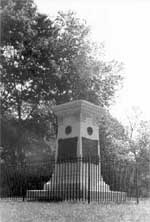





Survey of Historic Sites and Buildings
 |
FORT NECESSITY NATIONAL BATTLEFIELD Pennsylvania |
 Fort Necessity National Battlefield |
| ||
This battlefield primarily commemorates the opening engagement of the French and Indian War (1754-63), in which the English won from the French control of the North American Continent. Within the park area, however, stands the original Mount Washington Tavern, which has some significance in the phases of history treated in this volume. The tavern was a stage station on the National, or Cumberland, Road, which in the 1800's was a principal artery of traffic between the Atlantic sea board and the Ohio Valley.
 |
| Fort Necessity. |
French-English rivalry in the trans-Allegheny territory and in North America approached a climax in the 1750's. In 1754 the British sent Lt. Col. George Washington and a small force from Virginia to contest French possession of the Forks of the Ohio, where the French had erected Fort Duquesne. After defeating a French scouting party at Great Meadows, as the Fort Necessity area was then called, Washington built a temporary fort, which he called "Fort Necessity." In an ensuing clash, Washington's first major battle, the French forced the colonials to surrender, allowed them to return to Virginia, destroyed Fort Necessity, and returned to Fort Duquesne. This battle sparked the French and Indian War, which the British eventually won.
In 1769 Washington acquired a 234-1/2-acre tract of land at Great Meadows. He owned it until his death and in his will directed that it be sold along with his other properties. Judge Nathaniel Ewing later purchased it for a farm, and in 1818 erected a large house, which he called Mount Washington, near the newly opened National Road. Constructed of brick molded and burned from kilns on the farm, the house was the only substantial building for miles along the road, and Ewing soon opened it as a tavern and stage station. It subsequently passed through several hands and was a popular stopping place until the stage-lines went out of business in the 1850's. After the mid-19th century Godfrey Fazenbaker owned it and used it as a farmhouse. His heirs donated it to the Commonwealth of Pennsylvania. The tavern overlooks the site of Fort Necessity. Now Fort Necessity Museum, it contains relics of the Washington and Braddock campaigns; it also exhibits household furnishings and industrial, agricultural, and military equipment.
 |
| Fort Necessity. |
Fort Necessity National Battlefield became a part of the National Park System in 1933. In 1962 it absorbed Fort Necessity State Park, including sections of Great Meadows, scene of the 1754 battle and part of Which Washington later owned. A stockade, storehouse, and entrenchments have been reconstructed on the exact site of the original structures. The site of Washington's skirmish with the French scouting party and the grave of Gen. Edward Braddock, commander in chief of the British forces in the Battle of Monongahela (1755), also may be seen.
 |
 |
http://www.cr.nps.gov/history/online_books/founders-frontiersmen/sitea26.htm
Last Updated: 29-Aug-2005